
L'aviation sanitaire et la défense passive
Description
Au sein de la Croix-Rouge française, les femmes sont longtemps reléguées au rang de dames patronnesses. Ce n’est que lors de la Campagne du Maroc (1907) que des infirmières sont officiellement mobilisées. C’est d’ailleurs à ce moment-là que naît dans l’imaginaire militaire l’image de l’infirmière rassurante – image qui a encore beaucoup d’échos dans les représentations de la première guerre mondiale aujourd’hui. Au cours des décennies qui suivent, les bénévoles de la Croix-Rouge française seront de plus en plus déployées plus seulement pour soigner les blessés de guerre, mais aussi en cas de catastrophes naturelles, dans la lutte contre les épidémies et en soutient sanitaire à la population. Ce changement dans les activités de la Croix-Rouge amène les femmes à occuper un rôle de premier rang. Dès la fin de la Grande Guerre, la Croix-Rouge est d’ailleurs indissociablement associée à une figure féminine dans l’imaginaire populaire.
C’est dans ce contexte que les bénévoles et infirmières de la Croix-Rouge française s’autonomisent. Ainsi, en 1933, la marquise de Noaille donne l’impulsion pour la création de cours pour ‘infirmières convoyeuses en avion sanitaire’ et pour ‘femmes-pilotes aviatrices’. Ces femmes sont donc formées pour surveiller les blessés au cours des vols, de l’embarquement et du débarquement. En 1937, les sociétés de la Croix-Rouge Française créent même une équipe d’infirmières et de secouristes ‘parachutables’. On voit ici un entrainement d’une unité d’aviation sanitaire, en 1935.
Crédits
L'aviation sanitaire et la défense passive, Document Ligue des Sociétés de la Croix-Rouge et du Croissant-Rouge. Collection Musée international de la Croix-Rouge et du Croissant-Rouge, Genève
Tags
ImagesPhotographiesDans la même collection
Hôpital territorial de la Croix-Rouge “Vittorio Emanuele III”
Images, Photographies, Genre et diversité

Janet Ndoti pendant sa formation à l'hôpital King George V de Nairobi
Images, Expositions, Photographies, Genre et diversité

Une femme secouriste et deux hommes formés en sauvetage en mer
Images, Photographies, Genre et diversité

Un médecin militaire et une infirmière retirent un éclat de mine
Images, Photographies, Genre et diversité

Avec le Commandant Locker
Images, Photographies

HUMANITY par Henry Leutwyler
Textes, Livres, Objets, Affiches, Photographies


L'aviation sanitaire et la défense passive
Description
Au sein de la Croix-Rouge française, les femmes sont longtemps reléguées au rang de dames patronnesses. Ce n’est que lors de la Campagne du Maroc (1907) que des infirmières sont officiellement mobilisées. C’est d’ailleurs à ce moment-là que naît dans l’imaginaire militaire l’image de l’infirmière rassurante – image qui a encore beaucoup d’échos dans les représentations de la première guerre mondiale aujourd’hui. Au cours des décennies qui suivent, les bénévoles de la Croix-Rouge française seront de plus en plus déployées plus seulement pour soigner les blessés de guerre, mais aussi en cas de catastrophes naturelles, dans la lutte contre les épidémies et en soutient sanitaire à la population. Ce changement dans les activités de la Croix-Rouge amène les femmes à occuper un rôle de premier rang. Dès la fin de la Grande Guerre, la Croix-Rouge est d’ailleurs indissociablement associée à une figure féminine dans l’imaginaire populaire.
C’est dans ce contexte que les bénévoles et infirmières de la Croix-Rouge française s’autonomisent. Ainsi, en 1933, la marquise de Noaille donne l’impulsion pour la création de cours pour ‘infirmières convoyeuses en avion sanitaire’ et pour ‘femmes-pilotes aviatrices’. Ces femmes sont donc formées pour surveiller les blessés au cours des vols, de l’embarquement et du débarquement. En 1937, les sociétés de la Croix-Rouge Française créent même une équipe d’infirmières et de secouristes ‘parachutables’. On voit ici un entrainement d’une unité d’aviation sanitaire, en 1935.
Crédits
L'aviation sanitaire et la défense passive, Document Ligue des Sociétés de la Croix-Rouge et du Croissant-Rouge. Collection Musée international de la Croix-Rouge et du Croissant-Rouge, Genève
Tags
ImagesPhotographiesDans la même collection
Hôpital territorial de la Croix-Rouge “Vittorio Emanuele III”
Images, Photographies, Genre et diversité

Janet Ndoti pendant sa formation à l'hôpital King George V de Nairobi
Images, Expositions, Photographies, Genre et diversité

Une femme secouriste et deux hommes formés en sauvetage en mer
Images, Photographies, Genre et diversité

Un médecin militaire et une infirmière retirent un éclat de mine
Images, Photographies, Genre et diversité

Avec le Commandant Locker
Images, Photographies

HUMANITY par Henry Leutwyler
Textes, Livres, Objets, Affiches, Photographies

Un monde à guérir
16.11.2021 au 24.04.2022
Exposition, Au musée

Un monde à guérir aux Rencontres de la Photographie d’Arles
04.07.2022 au 25.09.2022
Exposition, Hors les murs

Une femme secouriste et deux hommes formés en sauvetage en mer
Images, Photographies, Genre et diversité

Janet Ndoti pendant sa formation à l'hôpital King George V de Nairobi
Images, Expositions, Photographies, Genre et diversité

Avec le Commandant Locker
Images, Photographies
